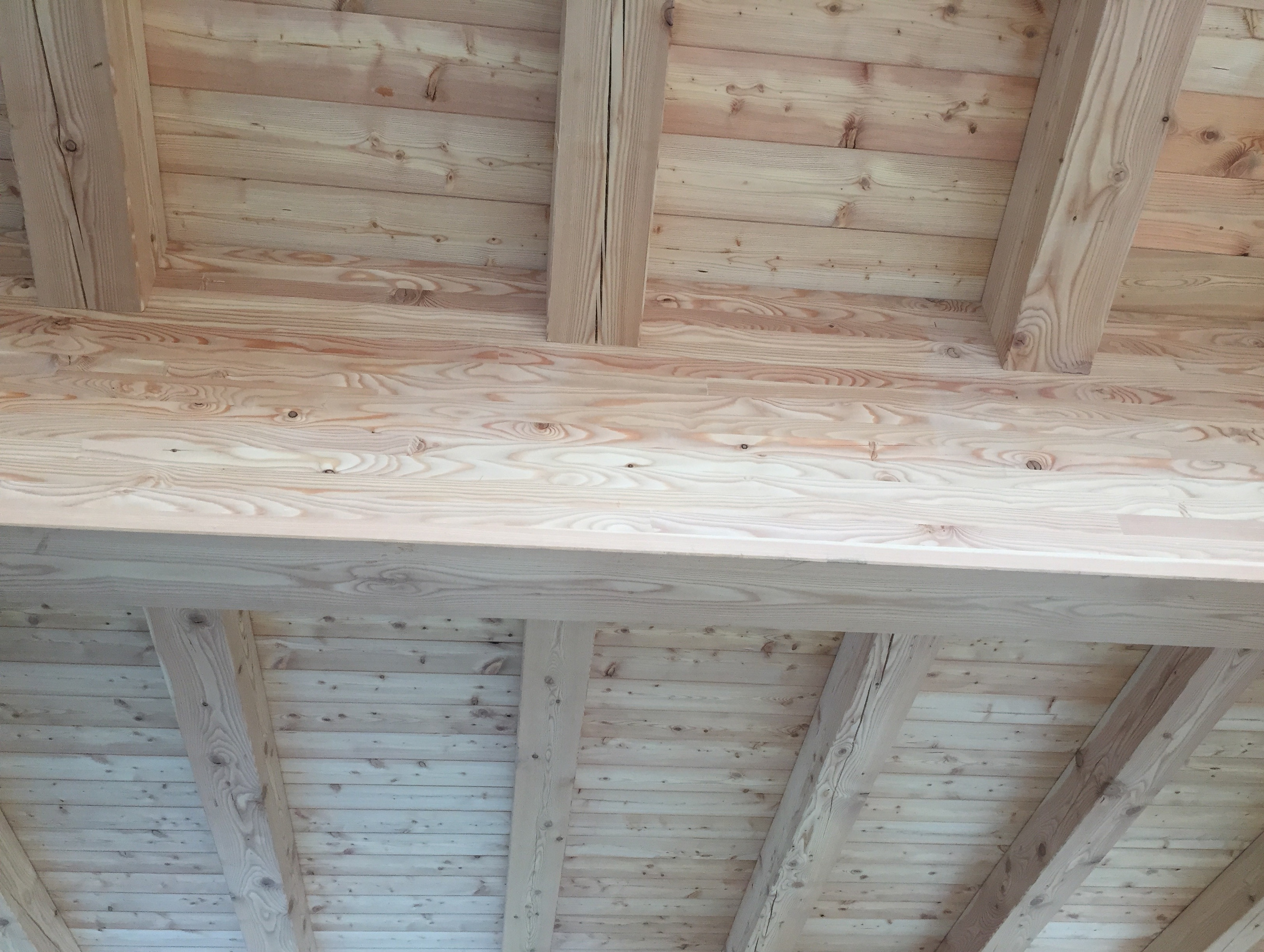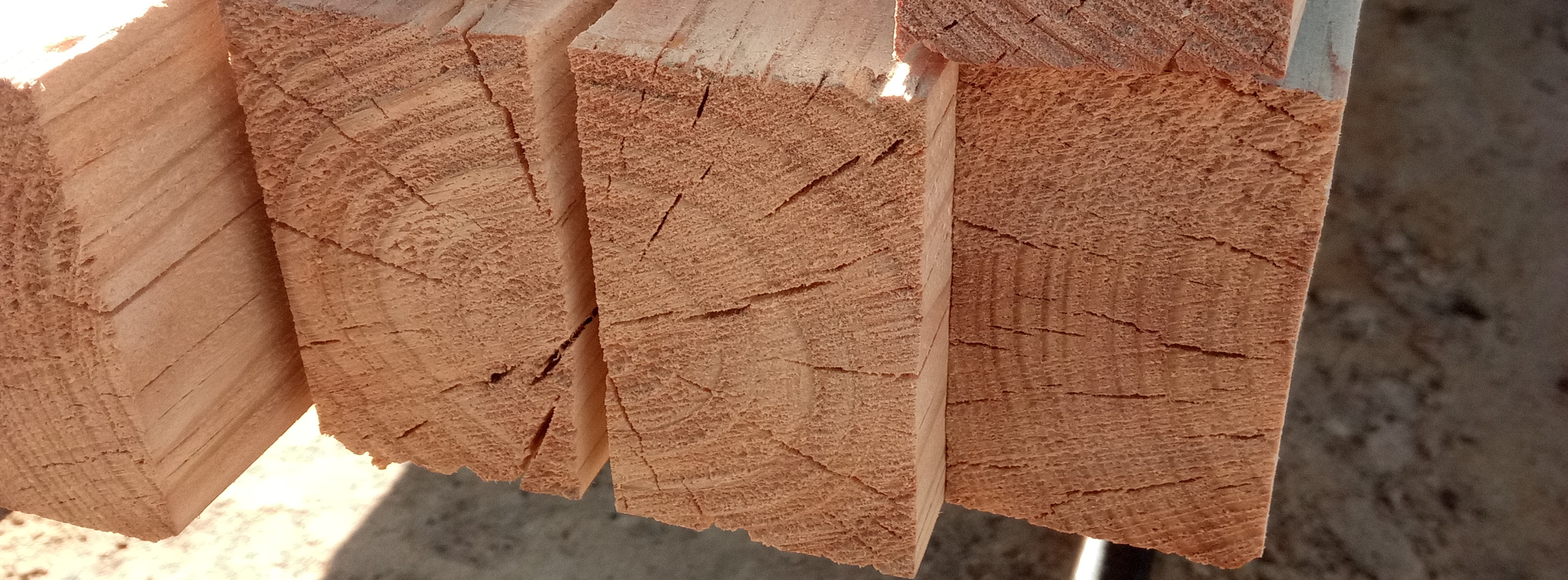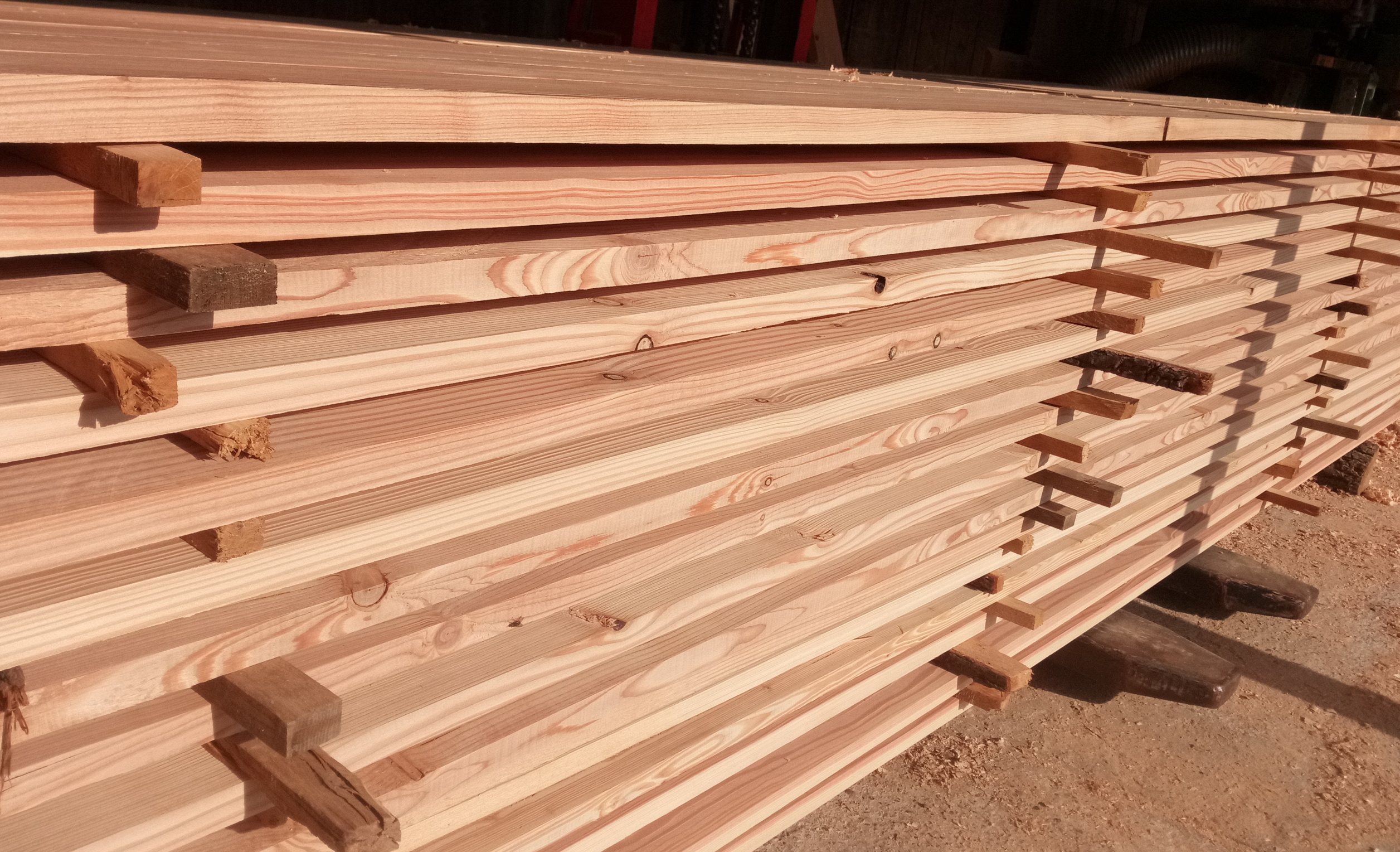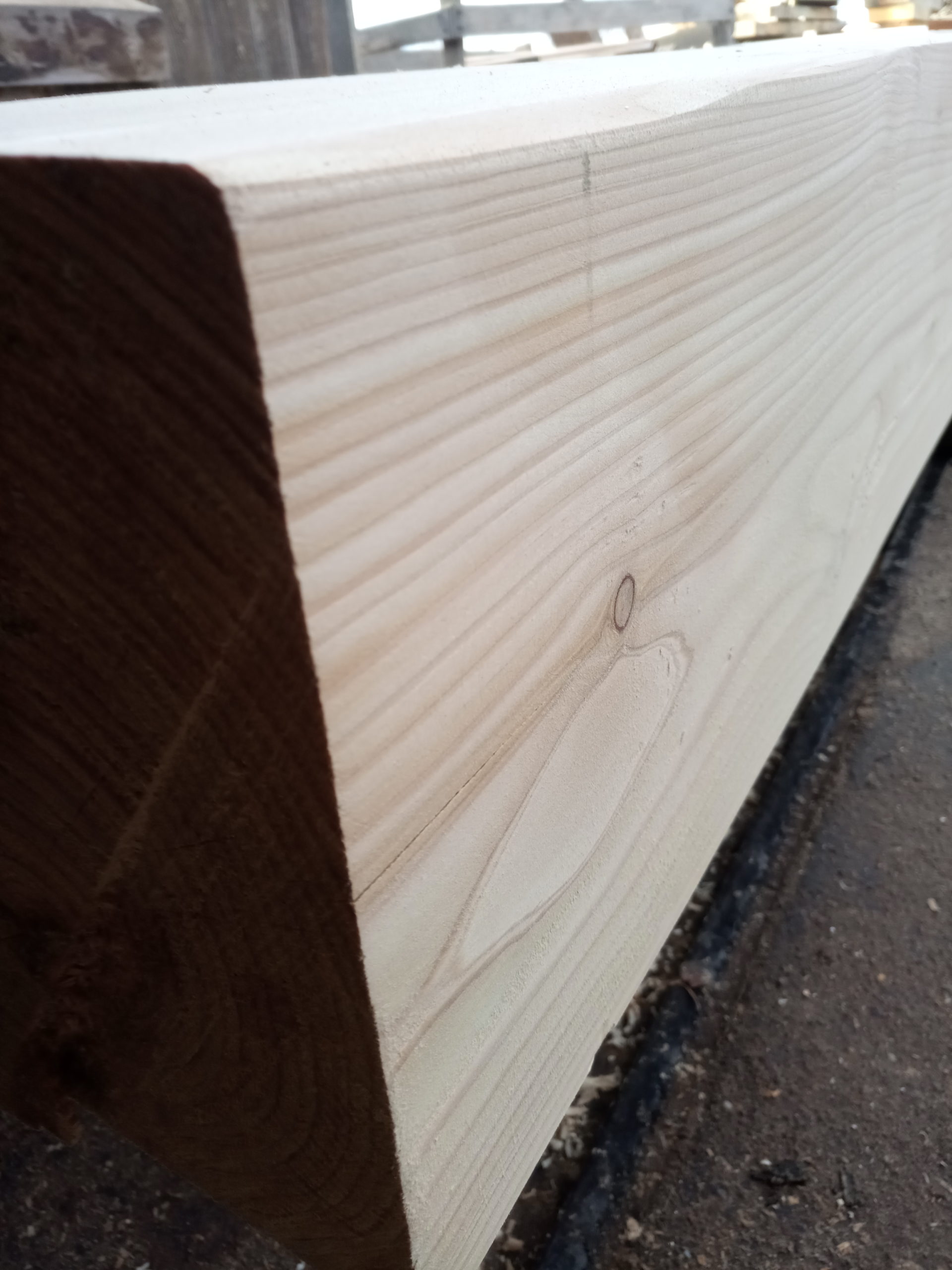Larch structures planed – ceilings, columns, swings, oak footbridge, pier, oak bridge, bridge, sluice, dam, composter, raised bed, terrace, pergola. We will make the material for your construction to measure, dry it, plane it or sand it.

WHICH LARCH STRUCTURES CAN WE MAKE FOR YOU?
Freshly sawn (tarred) larch lumber with unspecified moisture content
The disadvantage of using untreated lumber can be the high water content and the subsequent volume changes and deformation when it dries to equilibrium moisture content. The higher water content may also be problematic in terms of increased risk of attack by wood-boring insects, molds and fungi, but this is to a small extent in oak, as larch is resistant to such attack.
When buying raw timber, it is a good idea to choose the right quality for the application. In general, centre sawn timber, ideally radial with no pith content, will be the strongest and most stable.
On the other hand, incorporating elements made from uncured timber with pulp content can cause undesirable effects in the form of twisting, drying cracks, etc.
This product of basic sawmill processing is not losing its popularity in traditional carpentry constructions where a relatively wide range of cross-sectional dimensions are used – exterior structures, larch planks in the garden, raised beds, etc.


Technically dried, planed larch lumber
The profiles are made of technically dried larch lumber with guaranteed moisture content (exterior usually 15% ±3%, interior 10% ±2%). The centre lumber, ideally radial without pith content, will be the strongest and most stable and care is taken to cut the pith (centre of the log) during the primary cutting of the log. This ensures greater dimensional stability.
Four-sided planing or sanding and bevelled edges are a matter of course for self-dried planks, battens, planks or beams.
For the production of larch lumber, logs are used in the order of the first and second pieces from the bottom of the tree, with fewer cut branches (knots) and minimal curvature.
We will be happy to advise you on the selection of suitable material…




THE USE OF LARCH IN CONSTRUCTION?
Larch, especially Siberian larch, is a highly valued material in contemporary construction due to its excellent properties and wide range of applications.
Properties of larch
Hardness and durability: Siberian larch is considered the hardest conifer in the world, which gives it high strength and resistance to mechanical loads. Its dense wood approaches the hardness of oak, making it an ideal material for structures subjected to high loads
Moisture resistance: larch contains natural resins that repel water and prevent the growth of wood-destroying fungi. This property gives it an advantage in outdoor applications such as terraces and facades
Biological stability: larch wood is resistant to mold and insects, which extends its lifetime even in harsh conditions
Practical applications
Facade cladding: Due to its aesthetics and durability, larch is often used for cladding buildings
Flooring: solid larch floors are popular for their beautiful color and high durability. They can also be used for underfloor heating
Structural elements: Larch timbers are used as load-bearing structures, columns, rafters and other supporting elements
Garden structures: Often used for the manufacture of gazebos, pergolas, saunas and other garden structures
Siberian larch is a high quality and durable material for building applications, combining aesthetic qualities with practical benefits. Its uses range from interior furniture to exterior structures, making it a versatile solution for modern building projects.
HOW LONG WILL LARCH STRUCTURES LAST?
Larch structures, especially those made of Siberian larch, are characterized by high durability and resistance. According to expert sources, the lifetime of these structures is between 30 and 50 years, with some sources indicating the possibility of reaching up to 100 years depending on the quality of construction and maintenance
Factors influencing the durability of larch structures
Wood quality: Siberian larch has dense growth rings and a high resin content, which increases its resistance to moisture and rot
Maintenance: regular maintenance and the use of protective coatings can significantly extend the life of the wood. Without proper maintenance, wood can degrade more quickly
Structural protection: Proper design and construction is key. Poorly designed facades can lead to moisture problems and wood-boring fungus infestations
Specific applications
Facade cladding: These claddings can last up to 50 years if properly designed and maintained
Terraces: Larch terraces typically have a lifespan of around 25 years, but again this depends on maintenance and conditions of use
In conclusion, larch structures, especially those made from quality Siberian larch, can be very durable if proper construction practices and regular maintenance are followed.
MISTAKES WHEN INSTALLING LARCH STRUCTURES?
When installing larch structures, specific errors often occur that can affect the quality and durability of the entire project. Here are the most common mistakes and recommendations on how to avoid them:
Using poor quality timber
Insufficient drying: Using wood that has not been properly dried can lead to shape changes in the structure. The wood can shrink and crack, which compromises the finish
Insufficient grading: It is important to use only certified and graded wood that meets quality standards.
Errors in fitting joints
High number of joints: every joint is a potential place for error. Reducing the number of joints simplifies the process and reduces the risk
Improper joint design: Joints should be made with the utmost precision to avoid leaks or weakening of the structure.
Insufficient airtightness
Missing foils: In traditional systems, airtightness is provided by foils, which are prone to damage. Without proper securing, moisture and mold can penetrate
Inadequate sealing of penetrations: all penetrations through walls (e.g. for wiring) should be carefully sealed.
Insulation errors
Incorrect insulation placement: insulation should be placed in its entirety without gaps. Any gaps can lead to acoustic bridges and reduced insulation effectiveness
Use of inappropriate materials: it is important to choose quality insulation materials that meet the acoustic and thermal insulation requirements.
Installation techniques
Incorrect orientation of the boards: The boards should be oriented vertically to the vertical profiles, which ensures their stability
Not creating expansion joints: It is important to leave gaps (5-10 mm) around the perimeter structures for expansion to avoid cracking with temperature changes
Adherence to these principles and careful planning can significantly reduce the risk of mistakes when installing larch structures and ensure their longevity and functionality.
WHAT ARE THE PROPERTIES OF LARCH STRUCTURES?
High durability
Larch wood is known for its exceptional resistance to weather, rot and pests. Its high resin content ensures its resistance to moisture, making it suitable for outdoor use without the need for chemical treatment.
Long service life
Due to its durability, larch wood has a very long life, often exceeding decades. This characteristic makes it an economically viable investment for long-term projects.
Aesthetic appearance
Larch wood has a beautiful, warm color and a distinctive texture with summer rings. With time, it acquires an elegant silver-grey patina, giving the structures a rustic and natural look.
High strength
Larch timbers are very strong and have a high load-bearing capacity, which makes them suitable for structural elements that have to bear heavy loads. This material is ideal for load-bearing structures and other building elements.
Thermal insulation properties
Larch wood has good thermal insulation properties, which contributes to the energy efficiency of buildings and increases the comfort of living.
Environmentally friendly material
Larch is a renewable source of wood and its use contributes to sustainable construction. The wood is biodegradable and recyclable, which minimizes its ecological impact.
Possibilities of use
Outdoor buildings: ideal for pergolas, gazebos, terraces, fences and wooden facades.
Structural elements: used for trusses, beams and other load-bearing structures.
Interior elements: Suitable for wall cladding, ceilings and floors.
Furniture: Popular for making furniture due to its strength and aesthetic properties.
Larch structures are therefore an excellent choice for those seeking a combination of durability, aesthetics and environmental benefits in construction.
THE DURABILITY OF LARCH STRUCTURES?
Larch wood, especially Siberian larch, is valued for its high durability and strength, making it an ideal material for a variety of structural applications. This durability manifests itself in several key areas:
High mechanical strength
Larch timbers are capable of withstanding high mechanical loads, making them suitable for supporting and load-bearing structures such as columns, rafters and ceiling joists. Their strength and hardness increase during the natural drying of the wood and the polymerisation of the resins they contain.
Weather resistance
Larch wood is naturally resistant to moisture, frost, sunlight and other weather conditions. This resistance allows it to maintain its shape and dimensions even when exposed to rain or sea water. Larch contains a high proportion of natural resin, which gives it antibacterial properties and protects it from rot and wood-boring insect infestation.
Biological stability
Larch wood has high biological stability, which means that it is less susceptible to damage from fungi and mold. This property is particularly important in outdoor applications such as patios and garden structures.
Temperature stability
Larch wood has good thermal stability, which means that its properties do not change significantly with temperature fluctuations. This makes it a suitable material for use in different climatic conditions.
Due to its exceptional properties, larch wood is highly valued in the construction and furniture industries. Its combination of strength, weather resistance and biological stability makes it an ideal choice for long-lasting and reliable constructions.
THERMAL CONDUCTIVITY OF LARCH STRUCTURES?
The thermal conductivity of larch structures is usually between 0.12 and 0.15 W/m-K. This coefficient is important for assessing the insulating properties of wood and its ability to conduct heat. The lower the value of the thermal conductivity coefficient (λ), the better the insulating properties of the material.
Factors affecting the thermal conductivity of larch:
Moisture content: moisture content has a significant effect on the thermal conductivity of wood. High moisture content increases conductivity, while dry wood has better insulating properties.
Conductivity: The density of larch also contributes to its thermal conductivity; in general, denser wood has a higher thermal conductivity.
Comparison with other materials:
The thermal conductivity of larch is lower than many building materials such as concrete (1.2 – 1.6 W/m-K) or brick (0.8 – 1.0 W/m-K), making larch suitable for structures with energy efficiency requirements.
Larch structures thus offer good thermal insulation properties and are often used in construction for their aesthetic and functional advantages.
THE EFFECT OF MOISTURE ON LARCH STRUCTURES?
Moisture has a major effect on larch structures, both positive and negative. Larch timber is known for its high resistance to moisture and rot, making it an ideal choice for outdoor use. However, it can still be subject to problems if it is not properly protected or if excessive moisture build-up occurs.
Positive properties of larch wood
Moisture resistance: larch contains a resin that gives it natural protection against water and biological pests. This property increases its durability and makes it suitable for outdoor applications such as patios, gazebos and wooden structures in areas with high humidity.
Structural stability: when properly processed and dried, larch wood maintains its strength and flexibility even when moisture content changes.
Negative consequences of excessive humidity
Wood degradation: Humidity above 30% can lead to the development of micro-organisms that cause wood decay. Prolonged exposure to high humidity can cause mold and insect infestation, which significantly shortens the life of structures.
Volumetric changes: If larch timber is exposed to frequent changes in humidity, swelling and shrinkage occur, which can lead to deformations and cracks in the structure. These physical changes can affect not only the aesthetics but also the functionality of the building elements.
Causes of moisture build-up
Water infiltration: problems can arise due to rainwater infiltration into structures, especially if roof coverings are damaged or inadequately sealed.
Water vapor condensation: Internal condensation on the surface of timber elements can also contribute to an increase in moisture. This often happens in areas with inadequate ventilation.
Larch structures offer a great choice for outdoor use due to their resistance to moisture. However, it is essential to ensure proper protection from excessive moisture and to regularly check the condition of the structures to prevent degradation and prolong their life.
WHAT TYPE OF FINISH IS BEST FOR LARCH CONSTRUCTION?
Moisture has a major effect on larch structures, both positive and negative. Larch wood is known for its high resistance to moisture and rot, making it an ideal choice for outdoor use. However, it can still be subject to problems if it is not properly protected or if excessive moisture build-up occurs.
Positive properties of larch wood
Moisture resistance: larch contains a resin that gives it natural protection against water and biological pests. This property increases its durability and makes it suitable for outdoor applications such as patios, gazebos and wooden structures in areas with high humidity.
Structural stability: when properly processed and dried, larch wood maintains its strength and flexibility even when moisture content changes.
Negative consequences of excessive humidity
Wood degradation: Humidity above 30% can lead to the development of micro-organisms that cause wood decay. Prolonged exposure to high humidity can cause mold and insect infestation, which significantly shortens the life of structures.
Volumetric changes: If larch timber is exposed to frequent changes in humidity, swelling and shrinkage occur, which can lead to deformations and cracks in the structure. These physical changes can affect not only the aesthetics but also the functionality of the building elements.
Causes of moisture build-up
Water infiltration: problems can arise due to rainwater infiltration into structures, especially if roof coverings are damaged or inadequately sealed.
Water vapor condensation: Internal condensation on the surface of timber elements can also contribute to an increase in moisture. This often happens in areas with inadequate ventilation.
Larch structures offer a great choice for outdoor use due to their resistance to moisture. However, it is essential to ensure proper protection from excessive moisture and to regularly check the condition of the structures to prevent degradation and prolong their life.
Send us a quick request
you can also find us at:


